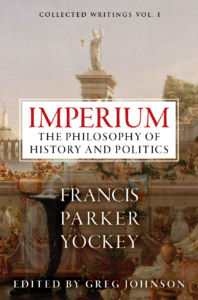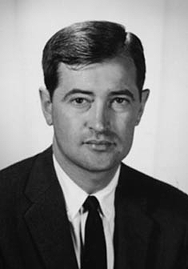The Cartos, Imperium, and the Truth Seeker — Remembering Willis Carto: July 17, 1926–October 26, 2015
1,511 words
A near-forgotten journal of occasional significance, The Truth Seeker, turned 150 years old last September. That makes it, by its own claim, the “World’s Oldest Freethought Publication.” Not that there’s an awful lot of competition there, unless you wish to make mischievous arguments in favor of The Atlantic Monthly or The Economist.
Over the years I crossed paths with the Truth Seeker a few times, yet somehow managed to remain oblivious to key points in its history. For example, I only recently discovered — or was reminded again — that The Truth Seeker Company was the original American publisher of Francis Parker Yockey’s Imperium. You will recall that the original edition was published in 1948 by Westropa Press in London. That was a very limited two-volume edition of 200 copies. In 1962 Truth Seeker editor and publisher Charles Lee Smith printed 2,000 copies of a one-volume cloth edition, which was afterwards distributed in hardbound and paperback editions by Willis Carto’s Noontide Press.[1]
At this point — I mean the early 1960s — the Truth Seeker was a low-circulation periodical published out of New York City. Since the 1920s it had focused largely on matters of race, eugenics, and the Jewish Question. When Charles Smith was dying in 1964, he moved the whole outfit to his biggest supporter, one James Hervey Johnson in San Diego. Johnson, a kind of Silas Marner loner-and-miser, set up operations in his Hillcrest neighborhood. There he grew papayas, sold Rightist books out of his little bookstore, and took daily selfies of himself, which he’d then paste into photo albums so he could follow his increasing decrepitude as he grew older.[2]
At one point I borrowed some of his photo albums from the Truth Seeker office to make copies. The later ones, showing his final years, were evidently not available. Or maybe he’d stopped taking selfies. He’d developed skin cancer on an ear, which he refused to get treated, and the ear sort of melted away in a hole of pus.

You can pre-order the Centennial Edition of Francis Parker Yockey’s Imperium here.
That is how the Cartos, Willis and Elisabeth, would describe it to me around 1993, anyway. We’d go out to dinner in the Gaslamp Quarter of downtown San Diego, and the Cartos would tell me how they’d drop in on Mr. Johnson periodically.
“I hated visiting him,” Elisabeth told me. “His ear was completely grotesque. And what he did was — it was almost all gone — he’d stick a rag in the hole. I couldn’t look.”
“We were always visiting him,” Willis added. As they knew him for about 25 years, that was a lot of visits. “And look what he did. Wasted his fortune.”
Johnson had died a few years before, in 1988, leaving an estate of about $17 million. This was fought over by a number of eager would-be legatees, notably Madalyn Murray O’Hair and her American Atheists organization. She didn’t get anything. Neither did the Cartos. On the other hand Noontide Press got to publish Imperium for some years, so their connection to the Truth Seeker wasn’t a complete loss.[3]
There was one person the Cartos and I knew who eventually drew a modest sum from the James Hervey Johnson Educational Foundation. That was Dr. Robert John, a psychiatrist and foreign-policy writer from Manhattan who’d been associated with the Truth Seeker since about 1960. In order to collect his six-figure grant, he had to write and publish a book that was friendly to J. H. Johnson’s anti-religious slant but weaseled around his belief in race differences and eugenics, and scarcely touched on the Jewish Question. This blameless book came to 100 pages (in paperback) and carried the title The Sage of San Diego Said Choose Quality and Reason. Dr. John gave me a few hundred dollars to make some radio ads, which we broadcast around midnight, the cheapest timeslot available, on station KGO. I understand we actually sold a few copies that way. The book is concise and readable. I really ought to review it here someday. The cover is most amusing, with the author himself looming like Godzilla over the San Diego waterfront skyline.
Unfortunately, the “World’s Oldest Freethought Publication” wasn’t always as interesting as it became during its eccentric decades of controversy, roughly the 1920s to the 1980s. Founded in 1873, it mainly pushed agnosticism and current science theories, or at least Darwinism, in its early decades. Its heroes were people such as orator and politician Robert Ingersoll (“the Great Agnostic”) and Thomas Paine. Paine, because Paine was some kind of irreverent Deist, I suppose, but mainly because Ingersoll was a big fan of Paine. The articles in the early Truth Seeker tended to be less about Freethought than about making tiresome swipes at Christianity and Scripture (“Was Abraham Lincoln a Christian?”, “Faith in the Bible Dying Out,” “Adam and Eve Story Is Actually Persian”), much in the manner of the militant, autistic atheists one encounters these days on social media. Separation of Church and State, a phrase that carried great gravitas in the late nineteenth century, is interpreted to mean using the power of the State to destroy the Church, or at least banish it from the public sphere.

You can buy The World in Flames: The Shorter Writings of Francis Parker Yockey here.
Some of these sentiments exist again in The Truth Seeker’s current incarnation. The onetime black-and-white hot-type monthly of the 1800s — though cheaply mimeographed in the J. H. Johnson days — now publishes three times a year, in glorious digital color and expensive coated paper. If you want a recent back issue, it’ll cost you $20. There’s still lots of Darwinism, and mockery of Christianity, and exaltation of Thomas Paine. Very little agnosticism, however. Agnosticism is an expression of doubt and thus long out of fashion. The current thing is to go whole hog, declare full-blown atheism, for There Is No God, religion is backwards and foolish, etc., etc. Robert Ingersoll is rolling in his grave.
On the fun side, though, this leaden “Freethought” material is often interlarded with rollicking hippie stuff. There’s the sort of Left-liberal writing that used to fill out Scanlan’s Monthly, Ramparts, and The Realist in the 1960s and ‘70s. As a matter of fact, when The Realist’s Paul Krassner died in 2019, the Truth Seeker made him the cover boy, describing The Realist as a kind of satirical Freethought spinoff of the Truth Seeker (bit of a stretch there, I think) and called him “arguably the Truth Seeker’s most irreverent Contributing Editor.” After a few hilarious remembrances of Krassner, the stern articles that follow, about Opus Dei (“Opus Dei’s Influence Is Felt in All of Washington’s Corridors of Power”) and abortion in Northern Ireland (“When Religious Ideology Drives Abortion Policy, Poor Women Suffer the Consequence”) read like parodies of Mother Jones and The Nation.
Sometimes the title of an article is just too tongue-in-cheek to be taken seriously. In 2022 we have “’Imagine’ at 50: Why John Lennon’s Ode to Humanism Still Resonates” by one Phil Zuckerman, who is said to teach at a place called Pitzer College. His article, praising the message of John Lennon’s worst song ever, is not, in fact, a joke.
By “ode to humanism,” Zuckerman doesn’t mean the tradition of Erasmus and More; “humanism” is just his euphemism for atheism, which he equates to cliché-ridden Leftism. By anointing it as humanism, Zuckerman proceeds to come out with such lofty pronouncements as
when it comes to things like wanting to help refugees, seeking to establish affordable health care, fighting climate change and being sensitive to racism and homophobia, the godless stand out as particularly moral.[4]
Which, of course, invites the question: Moral on whose scale? Not on most people’s, any more than “Imagine” is one of their top ten tunes.
Notes
[1] The second printing, from 1962, bears the imprint of The Truth Seeker, Park Row, New York. The paperback edition is from Noontide Press in Sausalito, 1969. In his biography of F. P. Yockey (Yockey: A Fascist Odyssey, 2018), Kerry Bolton writes that Alice MacFarlane Yockey wrote to Willis Carto in 1964 and 1969 to collect royalties on behalf of her two daughters. She reminded Carto that her sister-in-law, Vinette Yockey Coyne, had helped pay for the 1962 hardbound reprint. Carto replied that they had not made any money on the editions yet, but expected to soon.
[2] James Hervey Johnson (1901-1988) made his original fortune while young, in real estate. In the early 1930s he was the tax assessor for San Diego, both city and county. At one point in 1932 he claimed the San Diego Zoo was in arrears for $6,000, and held a public auction for all the animals, zoo fixtures, and even the “hay for the elephants.” No one would bid. The tax bill was settled when the Zoo deeded the animals and property to the city.
[3] A few months after the dinner I describe, the Cartos were ejected from the Institute for Historical Review’s Costa Mesa offices because their employees claimed they were misappropriating a $7 million legacy from Thomas Edison’s grandniece. Litigation went on for several years. I make this note here to point out how easily inheritances can go awry when legacies are not clearly spelled out and signed.
[4] Phil Zuckerman, “’Imagine’ at 50: Why John Lennon’s Ode to Humanism Still Resonates.” The Truth Seeker, Vol. 149, Jan.-Apr. 2022.




